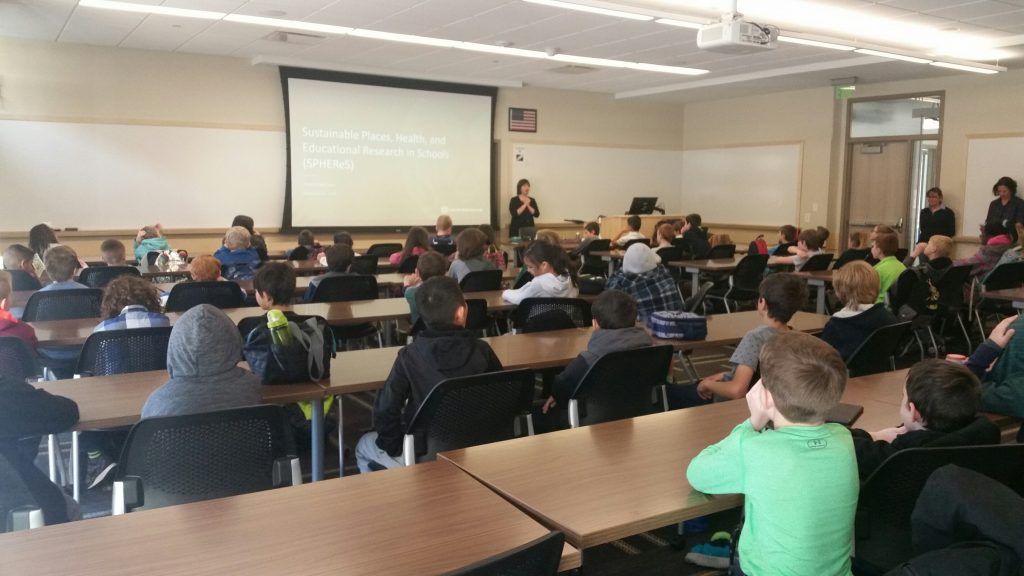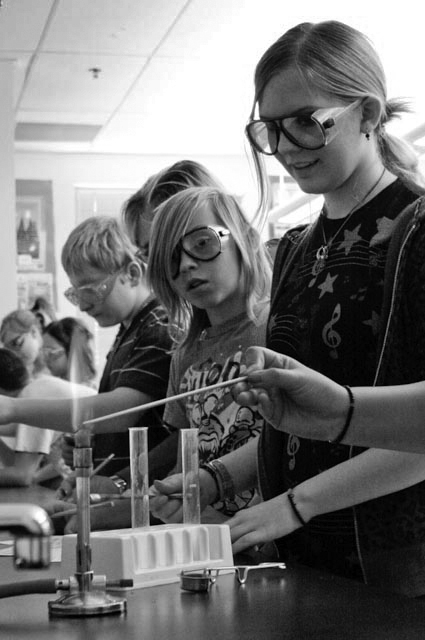By. Shannon Oliver
Walking the halls of North Mor Elementary School in Northglenn, Colorado, the design advisory group makes note of various building components for bond planning: movable partition walls (some of which don’t move well), operable windows that no longer operate, 20+ year-old egg-crate troffer light fixtures with tubular fluorescent lamps, stained and faded carpet, the list goes on. If this doesn’t sound like a newly built green school with the latest in indoor environmental quality (IEQ) considerations, it isn’t. The reality for Adams 12 Five Star Schools is that many of its 54 school buildings are more than 20 years-old. Concepts such as ample daylight, tunable LED lighting, and sound dampening wall coverings may not have been considered, or were even an option, when a majority of the district’s building stock was originally constructed. How then do you ensure adequate IEQ is equitably disbursed within an aging building stock?
For Adams 12, this journey began in the mid-2000s with the adoption of Collaborative for High Performance Schools (CHPS) design standards as part of the district’s technical guidelines for building design and construction. While this helped ensure integration of the latest design features during new building construction and major building renovations, it still left the bulk of existing buildings out of the conversation. Recognizing the need for a focused funding plan on an upcoming bond measure, Adams 12 took on the effort of setting an IEQ baseline for every district school per the Operations Report Card (ORC) protocol within the CHPS framework. This protocol provides a standard means to quantify the quality of a school building’s indoor environment for several key metrics. Adams 12 chose to focus on five metrics: light quality, energy efficiency, acoustic quality, thermal comfort, and indoor air quality. Results of the ORC were utilized to clarify funding needs and provide a baseline to demonstrate whether facility improvements resulted in an improved indoor environment.
When Colorado State University (CSU) learned of Adams 12’s ORC data and the plan to improve school facilities through bond work, it proved to be an excellent opportunity to conduct a research project under the U.S. Environmental Protection Agency’s (EPA) Sustainable Places, Health, and Educational Research in Schools grant. This grant sought to address the lack of research to scientifically substantiate anecdotal evidence that ‘green’ designed and retrofitted schools have a positive impact on human performance, including student health, academic achievement, employee health, and work satisfaction, compared to conventional school buildings. The CSU research team (which included researchers from CSU’s Department of Environmental and Radiological Health Sciences and the Institute for the Built Environment) wanted to utilize the ORC information, as well as additional objective measurements in the school, to compare the indoor environment to student performance data. Additionally, the EPA grant had earmarked funding for integrating an occupant engagement component alongside the research. Initially, integrating complex building and environmental quality science with existing curriculum seemed too complicated to carry out. However, the problem-based learning (PBL) model used by Adams 12 schools, with its focus on science, technology, engineering, and mathematics (STEM), was immediately recognized as a good fit for engagement. Planning for this collaborative PBL began in spring 2018 with student-led activities occurring during the 2018 – 2019 school year.
The PBL approach brings real-world problems, industry partners, and an iterative design and review process to students of all grade levels. Benefits of this model for students include fostering analytical thinking, honing presentation skills, encouraging teamwork, and receiving/utilizing feedback to improve their design or approach. This model perfectly fit with the engagement goals of the CSU/EPA work and Adams 12 STEM staff were excited to be involved. In developing the learning plan with the STEM coordinators and teachers, a model was created for integrating a variety of content, handheld tools, and external experts that could be deployed at grade levels from third-grade through high school. While specific implementation of this PBL project was flexible for each teacher and school, there were three overarching, primary learning objectives:
- Students will understand what is meant by IEQ and the concept of the indoor environmental biome.
- Students will recognize that components of the indoor environment can impact how they feel physically (e.g., headaches, etc.) and mentally (e.g., depression, etc.).
- Students will be able to measure discrete and aggregate components of their schools’ indoor environment to consider its impact on their daily activities.

A variety of tools were utilized to facilitate achievement of these learning objectives. These tools ranged from handheld devices to online tools and resources. The EPA grant had funding for the purchase of several handheld tools to quantify specific IEQ metrics, including CO2/temperature/humidity, light levels, noise levels, and energy use. Additionally, online spreadsheets and questionnaires (Google Sheets and Google Forms) were developed to track data and guide student investigations of the built environment. Finally, multiple in-class trainings were set up to bring in CSU and district experts to train teachers and students on how to use the handheld devices, discuss the principles of environmental sample collection and building operations, and introduce the idea of human health impacts from the built environment.
“Putting actual tools in the hands of our students, and exposing them to professionals in multiple scientific specialties, really made science real and highlighted the variety of fields that use basic math and science on a daily basis.” – Kate Kalver, STEM Coordinator – STEM Launch.
Bringing together a collaborative team to create an IEQ PBL for STEM programming ended up exposing more than 100 students in three schools and across multiple grades to a variety of scientific approaches and specialties. The diverse formats of content delivery – in-person experts, field trips, online data collection, handheld tools, and the iterative process of PBL development – led students on a journey of scientific approach and exploration. Students were excited to explore their school buildings and took ownership in documenting the quality of the indoor environment. Highlighting how indoor spaces are part of the ‘environment’ and that those spaces may negatively or positively impact how they feel was a key success for many students. One of the primary outcomes of this work was bringing school-based staff and administrators in facilities and maintenance closer together in understanding each other’s day-to-day needs and struggles. Additionally, CSU researchers now have a refined understanding of how to engage the primary education sector, which will inform future research and serve as a catalyst for greater collaboration. This work highlighted the need, and the opportunity, to get K-12 students engaged around the work of university researchers and the importance of bringing those K-12 students to research facilities. School-specific outcomes included installation of no-idling signs and implementation of a rideshare program at STEM Launch, fostered by the PBL work of sixth-graders there. Data collected by students at Northglenn High School sparked additional PBL projects, such as investigating the integration of rooftop solar at the school, as a new roof is slated under current bond work. STEM Lab students benefited most from a field visit to CSU, with numerous third- through sixth-graders stating they wanted to attend CSU in a science-based field when they are ready to go to college.
While there were many successes in the collaborative model of this project, there were some key lessons learned for all parties involved. CSU researchers began the project with a desired approach to implementing the learning model that would facilitate and enhance the grant’s research question. However, this project made clear that a more organic development of extra-curricular work in this space is needed. Indeed, the basis for the PBL model is to bring a specific, real-world problem to students so they can develop a solution. One issue that arose during this PBL project was that many of the IEQ metrics the students were investigating fell within commonly accepted ranges. So, what was the problem that students were supposed to be investigating? To address this, many teachers challenged their students to dig deeper and think about their relationship with the building. Lastly, all project partners agreed that too much complexity can be overwhelming in the PBL model. Based on the final two lessons learned mentioned here, it was determined that work of this nature was better handled as an exploratory or investigative unit-based approach versus a problem-based approach.

Using the building as a teaching tool is an excellent development to come out of the current green building revolution. How to bring this model into existing buildings, which may only receive limited upgrades to antiquated systems, hasn’t been broadly defined. The collaborative model used by Adams 12 and CSU, supported by EPA’s larger research aims, shed light on a replicable model to utilize existing buildings as a teaching tool. Key components for an endeavor of this nature include:
- At least one external partner that is an expert in the field being studied.
- Handheld tools and other engagement tools provided by experts in that field.
- An existing educational model and school staff or school-based partners who are excited and invested in implementing the project.
- Ideally, a succinct problem that is already known (e.g., thermal comfort issues or lighting concerns) that will foster investigation under the PBL model. Otherwise, an open-ended and investigative approach tied to a particular unit of study may be more appropriate versus the PBL model.
Administrators and school staff working in districts that don’t have new buildings planned or needed shouldn’t negate the importance and potential of using the building as a teaching tool. Real-world science and local partners are right at your fingertips and can be leveraged to enhance and engage building occupants in almost any setting. Organizations such as local and regional health departments, hospital systems, nonprofits, and universities have hard-working personnel in a variety of social, math, and science fields who are eager to share their knowledge with students and teachers.
This article was developed under Assistance Agreement No 83563501 awarded by the EPA. It has not been formally reviewed by EPA. The views expressed in this article are solely those of Shannon Oliver and do not necessarily reflect those of the Agency. EPA does not endorse any products or commercial services mentioned in this publication.
Author Bio
Shannon Oliver has a B.S. degree in Environmental Health from Colorado State University and a Master of Public Health degree in Global Environmental Health from Emory University. His professional experience includes eight years of environmental and regulatory compliance for the oil and gas industry and over three years as an Energy and Sustainability Manager in the K-12 sector in Colorado. Recent focus of Shannon’s work includes student engagement on energy conservation and waste reduction and district-level water use reduction efforts.

